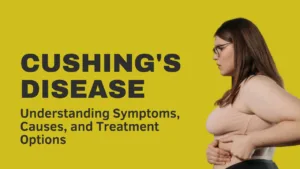Cushing’s Disease: Understanding of Symptoms, Causes, and Treatment Options

Introduction
Cushing’s disease is a rare hormonal disorder that affects both adults and children. It occurs when the body is exposed to high levels of the hormone cortisol for an extended period. In this comprehensive article, we will delve into the various aspects of Cushing’s disease, including its symptoms, causes, and treatment options. Join us as we explore this complex condition and shed light on its impact on individuals’ lives.
What is Cushing’s Disease?
Cushing’s disease is a condition characterized by excessive production of cortisol, a hormone produced by the adrenal glands. Cortisol plays a crucial role in regulating various bodily functions, including metabolism, immune response, and stress management. However, when cortisol levels become chronically elevated, it can lead to a range of symptoms and health complications.
Cushing’s disease is different from Cushing’s syndrome, as the former specifically refers to the condition caused by a pituitary gland tumor known as an adenoma. This tumor releases excessive amounts of adrenocorticotropic hormone (ACTH), which in turn stimulates the adrenal glands to produce more cortisol.
Symptoms and Diagnosis
The symptoms of Cushing’s disease can vary from person to person, but common manifestations include weight gain, especially in the abdomen, face, and upper back (referred to as a “moon face” and “buffalo hump”), thinning of the skin, easy bruising, muscle weakness, fatigue, high blood pressure, mood swings, and cognitive difficulties.
To diagnose Cushing’s disease, healthcare professionals utilize a combination of physical examinations, medical history assessments, and laboratory tests. These tests may include blood and urine tests to measure cortisol levels, as well as imaging studies such as MRI and CT scans to identify the presence of pituitary tumors.
Causes of Cushing’s Disease
The primary cause of Cushing’s disease is the presence of a pituitary gland tumor, specifically an adenoma. These tumors are usually benign, meaning they are not cancerous. The adenoma releases excessive amounts of ACTH, which stimulates the adrenal glands to overproduce cortisol. In rare cases, Cushing’s disease can also be caused by tumors in other parts of the body, such as the lungs or adrenal glands (also referred to as ectopic ACTH syndrome).
Risk Factors
While anyone can develop Cushing’s disease, certain factors may increase the likelihood of its occurrence. Women are more commonly affected than men, and individuals between the ages of 20 and 50 are at higher risk. Additionally, a family history of pituitary or adrenal gland tumors may predispose individuals to the disease. Certain medications, such as corticosteroids, can also contribute to the development of Cushing’s disease when used in high doses or over a long duration.
Treatment Options
The treatment of Cushing’s disease depends on several factors, including the underlying cause, severity of symptoms, and overall health of the individual. In many cases, the primary treatment approach is the surgical removal of the pituitary gland tumor. This procedure, known as transsphenoidal adenomectomy, involves accessing the tumor through the nasal passage or a small incision under the upper lip.
If surgery is not an option or if the tumor cannot be completely removed, other treatment modalities may be considered. Medications such as cortisol-lowering drugs can help manage symptoms and reduce cortisol production. In some cases, radiation therapy may be utilized to shrink tumors or inhibit their growth. Adrenal gland surgery may be necessary if the tumor is located in the adrenal glands.
Living with Cushing’s Disease
Managing Cushing’s disease involves a comprehensive approach that goes beyond medical interventions. Individuals living with the condition may need to make lifestyle modifications to support their overall well-being. This may include adopting a healthy and balanced diet, engaging in regular exercise, managing stress levels, and getting sufficient rest and sleep. Emotional support from healthcare professionals, support groups, and loved ones can also be instrumental in coping with the challenges associated with Cushing’s disease.
Conclusion
Cushing’s disease is a complex disorder that requires careful understanding and management. Recognizing the symptoms, seeking an early diagnosis, and exploring appropriate treatment options are crucial for individuals with the condition. With proper medical care, lifestyle adjustments, and emotional support, individuals with Cushing’s disease can lead fulfilling lives. It is important to consult with healthcare professionals for accurate diagnosis and personalized treatment plans.
FAQs (Frequently Asked Questions)
1. Can Cushing’s disease be cured?
Yes, Cushing’s disease can be cured with appropriate treatment. The choice of treatment depends on the underlying cause and individual circumstances.
2. Are there any alternative treatment options?
While traditional medical interventions are the primary approach to treating Cushing’s disease, some alternative therapies may help manage symptoms. However, it’s crucial to consult with healthcare professionals before pursuing any alternative treatments.
3. What are the possible complications of Cushing’s disease?
If left untreated, Cushing’s disease can lead to severe complications, including diabetes, high blood pressure, osteoporosis, cardiovascular diseases, and mental health issues.
4. Can children be affected by Cushing’s disease?
Yes, children can be affected by Cushing’s disease. It is important to monitor any unusual symptoms in children and seek medical attention if necessary.
5. Is Cushing’s disease preventable?
While there is no surefire way to prevent Cushing’s disease, managing underlying conditions and leading a healthy lifestyle can help reduce the risk factors associated with the disease.
Also, Visit: Health and Wellness